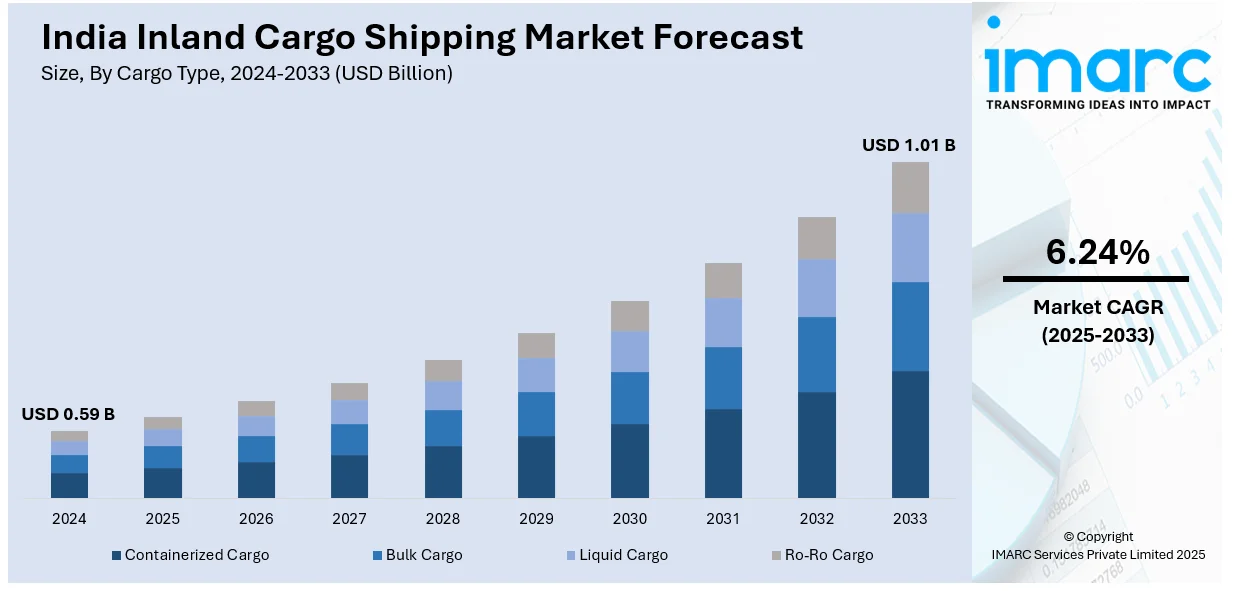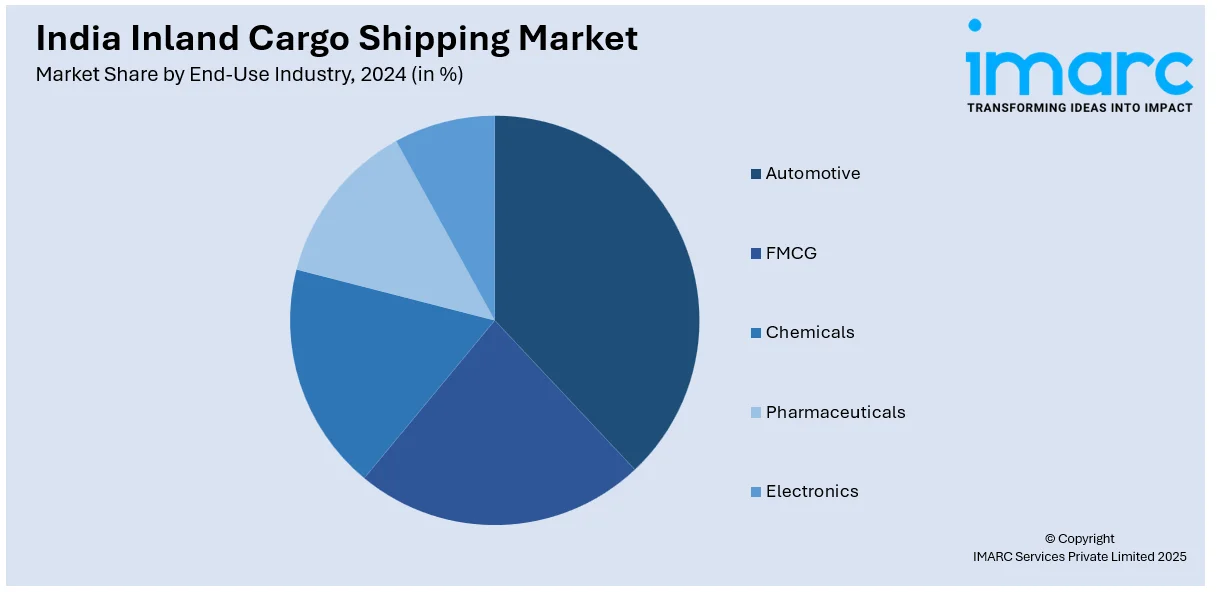
India Inland Cargo Shipping Market Size, Share, Trends and Forecast by Cargo Type, Mode of Transport, Service Type, End-Use Industry, and Region, 2025-2033
India Inland Cargo Shipping Market Overview:
The India inland cargo shipping market size reached USD 0.59 Billion in 2024. Looking forward, IMARC Group expects the market to reach USD 1.01 Billion by 2033, exhibiting a growth rate (CAGR) of 6.24% during 2025-2033. Growth in domestic trade, government investments in waterway infrastructure, cost-effective transportation, and rising demand for sustainable logistics are the factors driving the growth of the market. Enhanced connectivity, technological advancements, and policy support are further boosting the sector’s expansion and efficiency.
|
Report Attribute
|
Key Statistics
|
|---|---|
|
Base Year
|
2024 |
|
Forecast Years
|
2025-2033
|
|
Historical Years
|
2019-2024
|
| Market Size in 2024 | USD 0.59 Billion |
| Market Forecast in 2033 | USD 1.01 Billion |
| Market Growth Rate (2025-2033) | 6.24% |
India Inland Cargo Shipping Market Trends:
Expanding Private Participation in Inland Waterways
India's inland cargo shipping sector is witnessing increased private and public investment in infrastructure development. New regulatory measures are enabling businesses to construct jetties and terminals, fostering greater participation in cargo transportation. By streamlining approval processes and offering long-term operational rights, the initiative aims to boost trade efficiency, logistics capacity, and multimodal connectivity. With improved infrastructure and expanded private involvement, inland waterways are set to become a cost-effective and sustainable alternative for cargo movement. This shift aligns with the broader push for economic growth through optimized transport networks, reducing dependency on traditional freight methods. As regulatory frameworks encourage investment, inland waterways are poised to play a more significant role in India's logistics and trade ecosystem. For example, in March 2025, the Inland Waterways Authority of India (IWAI) introduced the National Waterways Regulations, permitting private, public, and joint ventures to construct jetties and terminals on national waterways. Developers must obtain a 'no objection certificate' from IWAI, with permanent terminals granted lifetime operation and temporary ones an initial five-year term, extendable. This move aims to enhance investment, trade, and economic growth in India's inland waterways sector.

To get more information of this market, Request Sample
Expanding Urban Water Transport for Sustainable Mobility
India is focusing on developing urban water transport systems to enhance connectivity and reduce congestion in major cities. By utilizing existing navigable waterways, the initiative aims to create efficient and eco-friendly transport networks linking mainland areas, municipalities, and islands. Feasibility studies are underway to assess the potential of integrating water metros into urban infrastructure, providing a cost-effective and sustainable alternative to road-based transit. This shift toward water-based mobility supports multimodal transport solutions, easing pressure on overcrowded road networks while promoting environmentally friendly commuting. As cities look to modernize transportation, inland water systems are emerging as a viable option to boost connectivity, reduce travel time, and enhance urban mobility across key regions in the country. For instance, in February 2025, the Inland Waterways Authority of India (IWAI) commissioned Kochi Metro Rail Limited (KMRL) to conduct feasibility studies for urban water transport systems in 17 cities across 12 states. Targeted locations include Ayodhya, Guwahati, Kolkata, Mumbai, and Varanasi. This initiative aims to develop safe, efficient, and eco-friendly water metro systems, leveraging existing navigable waterways to connect mainland areas, municipalities, panchayats, and islands, thereby enhancing multimodal connectivity.
India Inland Cargo Shipping Market Segmentation:
IMARC Group provides an analysis of the key trends in each segment of the market, along with forecasts at the region/country level for 2025-2033. Our report has categorized the market based on cargo type,mode of transport, service type, and end-use industry.
Cargo Type Insights:
- Containerized Cargo
- Bulk Cargo
- Liquid Cargo
- Ro-Ro Cargo
The report has provided a detailed breakup and analysis of the market based on the cargo type. This includes containerized cargo, bulk cargo, liquid cargo, and ro-ro cargo.
Mode of Transport Insights:
- Inland Waterways
- Coastal Shipping
- Transoceanic Shipping
A detailed breakup and analysis of the market based on the mode of transport have also been provided in the report. This includes inland waterways, coastal shipping, and transoceanic shipping.
Service Type Insights:
- Freight Forwarding
- Warehousing and Distribution
- Customs Brokerage
The report has provided a detailed breakup and analysis of the market based on the service type. This includes freight forwarding, warehousing and distribution, and customs brokerage.
End-Use Industry Insights:

- Automotive
- FMCG
- Chemicals
- Pharmaceuticals
- Electronics
A detailed breakup and analysis of the market based on the end-use industry has also been provided in the report. This includes automotive, FMCG, chemicals, pharmaceuticals, and electronics.
Regional Insights:
- North India
- South India
- East India
- West India
The report has also provided a comprehensive analysis of all the major regional markets, which include North India, South India, East India, and West India.
Competitive Landscape:
The market research report has also provided a comprehensive analysis of the competitive landscape. Competitive analysis such as market structure, key player positioning, top winning strategies, competitive dashboard, and company evaluation quadrant has been covered in the report. Also, detailed profiles of all major companies have been provided.
India Inland Cargo Shipping Market News:
- In February 2025, Adani Ports and Special Economic Zone (APSEZ) handled 36.5 million metric tonnes (MMT) of cargo, reflecting a 3% year-on-year (YoY) increase. India's inland cargo shipping sector is expanding, driven by rising container (20% YoY) and liquid cargo volumes. In FY2024-25 (April-February), total cargo volume grew 7% YoY to 408.7 mmt. Improved logistics infrastructure and rail connectivity further boost trade efficiency and multimodal transport integration.
- In February 2025, the Inland Waterways Terminal (IWT) at Jogighopa, Assam, was inaugurated, marking a significant advancement in India's inland cargo shipping sector. Strategically located 91 km from Gelephu, Bhutan, and 108 km from the Bangladesh border, the terminal is poised to enhance trilateral trade among India, Bhutan, and Bangladesh.
India Inland Cargo Shipping Market Report Coverage:
| Report Features | Details |
|---|---|
| Base Year of the Analysis | 2024 |
| Historical Period | 2019-2024 |
| Forecast Period | 2025-2033 |
| Units | Billion USD |
| Scope of the Report |
Exploration of Historical Trends and Market Outlook, Industry Catalysts and Challenges, Segment-Wise Historical and Future Market Assessment:
|
| Cargo Types Covered | Containerized Cargo, Bulk Cargo, Liquid Cargo, Ro-Ro Cargo |
| Modes of Transport Covered | Inland Waterways, Coastal Shipping, Transoceanic Shipping |
| Service Types Covered | Freight Forwarding, Warehousing and Distribution, Customs Brokerage |
| End-Use Industry Covered | Automotive, FMCG, Chemicals, Pharmaceuticals, Electronics |
| Regions Covered | North India, South India, East India, West India |
| Customization Scope | 10% Free Customization |
| Post-Sale Analyst Support | 10-12 Weeks |
| Delivery Format | PDF and Excel through Email (We can also provide the editable version of the report in PPT/Word format on special request) |
Key Benefits for Stakeholders:
- IMARC’s industry report offers a comprehensive quantitative analysis of various market segments, historical and current market trends, market forecasts, and dynamics of the India inland cargo shipping market from 2019-2033.
- The research report provides the latest information on the market drivers, challenges, and opportunities in the India inland cargo shipping market.
- Porter's five forces analysis assist stakeholders in assessing the impact of new entrants, competitive rivalry, supplier power, buyer power, and the threat of substitution. It helps stakeholders to analyze the level of competition within the India inland cargo shipping industry and its attractiveness.
- Competitive landscape allows stakeholders to understand their competitive environment and provides an insight into the current positions of key players in the market.
Key Questions Answered in This Report
The inland cargo shipping market in India was valued at USD 0.59 Billion in 2024.
The India inland cargo shipping market is projected to exhibit a CAGR of 6.24% during 2025-2033, reaching a value of USD 1.01 Billion by 2033.
India inland cargo shipping market growth is fueled by enhanced multimodal logistics, National Waterways expansion, and government-sponsored infrastructure initiatives. The Sagarmala Project and Public-Private Partnerships (PPPs) improve connectivity, alleviate road congestion, and decrease freight charges. Focus on environmentally friendly transportation and escalating trade volumes support inland water transport as a cost-efficient logistics option.
Need more help?
- Speak to our experienced analysts for insights on the current market scenarios.
- Include additional segments and countries to customize the report as per your requirement.
- Gain an unparalleled competitive advantage in your domain by understanding how to utilize the report and positively impacting your operations and revenue.
- For further assistance, please connect with our analysts.
 Request Customization
Request Customization
 Speak to an Analyst
Speak to an Analyst
 Request Brochure
Request Brochure
 Inquire Before Buying
Inquire Before Buying




.webp)




.webp)












